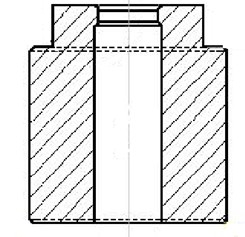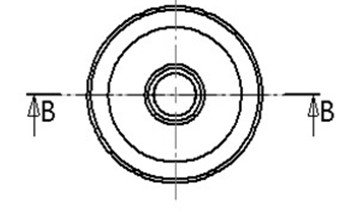Secondary continuous extrusion processing method of magnesium alloy and die plate insert for secondary continuous extrusion processing method
A die insert, extrusion processing technology, applied in metal extrusion dies, metal extrusion, metal processing equipment and other directions, can solve the problems of increasing human and material consumption, product cracks, material performance improvement, etc., to improve industrial production. Efficiency, excellent mechanical properties, the effect of reducing production costs
- Summary
- Abstract
- Description
- Claims
- Application Information
AI Technical Summary
Problems solved by technology
Method used
Image
Examples
Embodiment 1
[0028] Mg 98 Zn 1.92 Gd 0.08 (at. %, Alloy 1) and Mg 96.83 Zn 2.7 Gd 0.47 (at. %, Alloy 2)
[0029] Alloy 1 and Alloy 2 were homogenized at 400°C for 8 hours and then cooled by water quenching. Preheat the two alloys to 100°C, preheat the mold to 80°C, carry out traditional extrusion and secondary continuous extrusion, put the heated magnesium or magnesium alloy billet into the extrusion cavity of the heated mold, extrude The punching head extruded the billet at a speed of 0.1m / min, and the extrusion ratio was 4:1. It was found that the two alloys could not realize the traditional extrusion at this temperature, but they could realize the secondary continuous extrusion and the shape was perfect. Image 6 is the microstructure photo of Alloy 1 (a) and Alloy 2 (b) after two consecutive extrusions (the arrows indicate the direction of extrusion), Figure 7 It is the room temperature mechanical properties diagram of alloy 1 and alloy 2 after secondary continuous extrusion....
Embodiment 2
[0031] Mg 98.25 Zn 1.5 Gd 0.25 (at. %, Alloy 3) conventional extrusion with Mg 98.25 Zn 1.5 Gd 0.25 (at. %, Alloy 3) Comparison of two consecutive extrusions
[0032]Alloy 3 was directly subjected to conventional extrusion (diameter 37mm to 12mm) and secondary continuous extrusion (diameter 37mm to 15mm, then extrusion to 12mm) in the cast state. The billet preheating temperature is 100°C, the mold preheating temperature is 100°C, the extrusion ratio is 9:1, and the extrusion punch speed is 0.12mm / min. Figure 8 a is the microstructure photo of Alloy 3 after conventional extrusion, Figure 8 b is the microstructure photo of alloy 3 after secondary continuous extrusion. Due to the low extrusion temperature, the recrystallization of the material is incomplete, and the recrystallization grains are very small. Figure 9 It is the room temperature mechanical properties diagram of alloy 3 after traditional extrusion and secondary continuous extrusion. As can be seen from th...
Embodiment 3
[0034] Mg 98.25 Zn 1.5 Gd 0.25 (at. %, Alloy 3)
[0035] Alloy 3 was homogenized at 400°C for 8 hours and then subjected to traditional extrusion. The billet preheating temperature was 400°C, the mold preheating temperature was 370°C, the extrusion ratio was 25:1, and the extrusion punch speed was 2mm / min. Yield strength 170MPa, elongation 19%. The alloy was subjected to secondary continuous extrusion (diameter 60mm extruded to 15mm, and then extruded to 12mm). The billet preheating temperature is 400°C, the mold preheating temperature is 370°C, the extrusion ratio is 25:1, and the extrusion punch speed is 2mm / min. After secondary extrusion, the yield strength of Alloy 3 is 180MPa. Compared with the traditional extrusion, the yield strength increases by about 6%, while the elongation is 22%, and the elongation increases by about 16%.
PUM
| Property | Measurement | Unit |
|---|---|---|
| crystal size | aaaaa | aaaaa |
| yield strength | aaaaa | aaaaa |
| yield strength | aaaaa | aaaaa |
Abstract
Description
Claims
Application Information
 Login to View More
Login to View More - R&D
- Intellectual Property
- Life Sciences
- Materials
- Tech Scout
- Unparalleled Data Quality
- Higher Quality Content
- 60% Fewer Hallucinations
Browse by: Latest US Patents, China's latest patents, Technical Efficacy Thesaurus, Application Domain, Technology Topic, Popular Technical Reports.
© 2025 PatSnap. All rights reserved.Legal|Privacy policy|Modern Slavery Act Transparency Statement|Sitemap|About US| Contact US: help@patsnap.com



